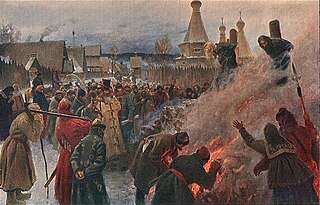
Death by burning is an execution, murder, or suicide method involving combustion or exposure to extreme heat. It has a long history as a form of public capital punishment, and many societies have employed it as a punishment for and warning against crimes such as treason, heresy, and witchcraft. The best-known execution of this type is burning at the stake, where the condemned is bound to a large wooden stake and a fire lit beneath.

George Jeffreys, 1st Baron Jeffreys, also known as "the Hanging Judge", was a Welsh judge. He became notable during the reign of King James II, rising to the position of Lord Chancellor. His conduct as a judge was to enforce royal policy, resulting in a historical reputation for severity and bias.

The Bloody Assizes were a series of trials started at Winchester on 25 August 1685 in the aftermath of the Battle of Sedgemoor, which ended the Monmouth Rebellion in England.

The Rye House Plot of 1683 was a plan to assassinate King Charles II of England and his brother James, Duke of York. The royal party went from Westminster to Newmarket to see horse races and were expected to make the return journey on 1 April 1683, but because there was a major fire in Newmarket on 22 March, the races were cancelled, and the King and the Duke returned to London early. As a result, the planned attack never took place.

The Popish Plot was a fictitious conspiracy invented by Titus Oates that between 1678 and 1681 gripped the kingdoms of England and Scotland in anti-Catholic hysteria. Oates alleged that there was an extensive Catholic conspiracy to assassinate Charles II, accusations that led to the executions of at least 22 men and precipitated the Exclusion Bill Crisis. During this tumultuous period, Oates weaved an intricate web of accusations, fueling public fears and paranoia. However, as time went on, the lack of substantial evidence and inconsistencies in Oates's testimony began to unravel the plot. Eventually, Oates himself was arrested and convicted for perjury, exposing the fabricated nature of the conspiracy.
Alice, Lady Lisle, commonly known as Alicia Lisle or Dame Alice Lyle, was a landed lady of the English county of Hampshire, who was executed for harbouring fugitives after the defeat of the Monmouth Rebellion at the Battle of Sedgemoor. While she seems to have leaned to Royalism, she combined this with a decided sympathy for religious dissent. She is known to history as Lady Lisle although she has no claim to the title; her husband was a member of the "Other House" created by Oliver Cromwell and "titles" deriving from that fact were often used after the Restoration.
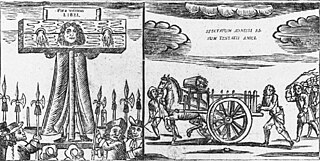
Thomas Dangerfield was an English conspirator, who became one of the principal informers in the Popish Plot. His violent death at the hands of the barrister Robert Francis was clearly a homicide, although whether the killing was murder or manslaughter was a matter of considerable public debate at the time.
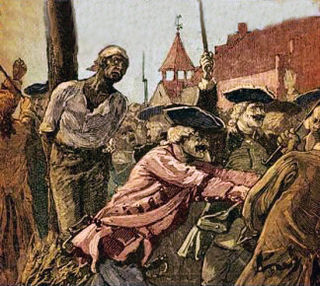
The Conspiracy of 1741, also known as the Slave Insurrection of 1741, was a purported plot by slaves and poor whites in the British colony of New York in 1741 to revolt and level New York City with a series of fires. Historians disagree as to whether such a plot existed and, if there was one, its scale. During the court cases, the prosecution kept changing the grounds of accusation, ending with linking the insurrection to a "Popish" plot by Spaniards and other Catholics.
Catherine Murphy was an English counterfeiter, the last woman in England to be officially burned at the stake.
Events from the year 1685 in England. This year sees a change of monarch.

Richard Rumbold (1622–1685) was a Parliamentarian soldier and political radical, exiled for his role in the 1683 Rye House Plot and later executed for taking part in the 1685 Argyll's Rising.

Elizabeth Cellier, commonly known as the "Popish Midwife", was a notable Catholic midwife in seventeenth-century England. She stood trial for treason in 1679 for her alleged part in the "Meal-Tub Plot" against the future King James II, but was eventually freed. Cellier was later imprisoned for allegations made in her 1680 work Malice Defeated, in which she recounted the events of the alleged conspiracy against the future King. She later became a pamphleteer and advocated for advancements in the field of midwifery. Cellier published A Scheme for the Foundation of a Royal Hospital in 1687, where she outlined plans for a hospital and a college for instructions in midwifery, as well as proposing that midwives of London should enter into a corporation and use their fees to establish parish houses where any woman could give birth. Cellier resided in London, England until her death.
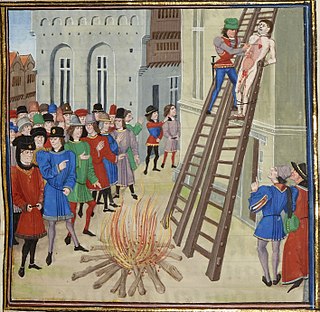
To be hanged, drawn and quartered became a statutory penalty for men convicted of high treason in the Kingdom of England from 1352 under King Edward III (1327–1377), although similar rituals are recorded during the reign of King Henry III (1216–1272). The convicted traitor was fastened to a hurdle, or wooden panel, and drawn behind a horse to the place of execution, where he was then hanged, emasculated, disembowelled, beheaded, and quartered. His remains would then often be displayed in prominent places across the country, such as London Bridge, to serve as a warning of the fate of traitors. For reasons of public decency, women convicted of high treason were instead burned at the stake.
Henry Cornish was a London alderman, executed in the reign of James II of England.
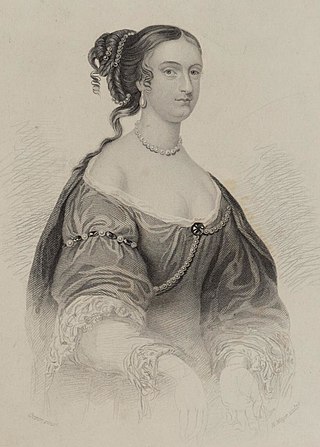
Rachel, Lady Russell was an English noblewoman, heiress, and author. Her second husband was William, Lord Russell, who was implicated in the Rye House Plot and later executed. A collection of the many letters she wrote to her husband and other distinguished men was published in 1773.
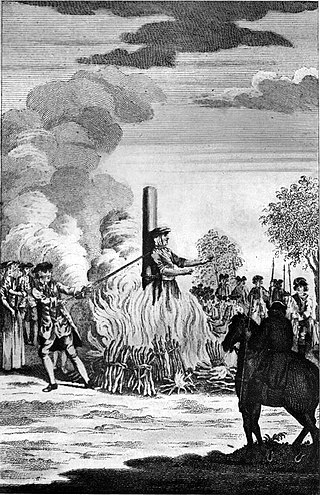
In England, burning was a legal punishment inflicted on women found guilty of high treason, petty treason, and heresy. Over a period of several centuries, female convicts were publicly burnt at the stake, sometimes alive, for a range of activities including coining and mariticide.
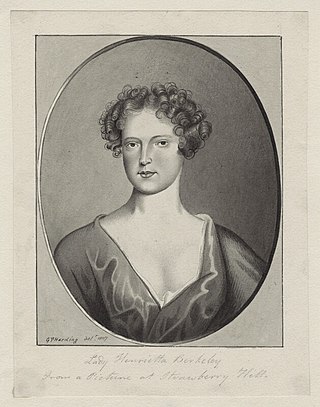
Lady Henrietta Berkeley was an English aristocrat notorious for having an affair with her elder sister's husband, Lord Grey of Warke. The affair began in 1681 when Berkeley was not yet an adult and was discovered by her mother the following year. Berkeley was removed to the family seat at Epsom. She escaped and went into hiding in lodging houses in London, under the protection of Grey. Her father, George Berkeley, 1st Earl of Berkeley, sued her lover in a trial which became a sensation in 1682.
Ann Smith was an English anti-Catholic political activist. A devout Baptist, she and her family sheltered the rebel 9th Earl of Argyll when he was in hiding in London and fled with him to the Spanish Netherlands in 1683. She lived with her husband in Utrecht and following his death funded Argyll's Rising in Scotland and the contemporaneous Monmouth Rebellion in England. She hosted fellow conspirator Elizabeth Gaunt in Amsterdam and received a royal pardon for her activism in 1686, after which time records of her life cease.
Prudence Lee was an English woman who was executed for murder in London.











